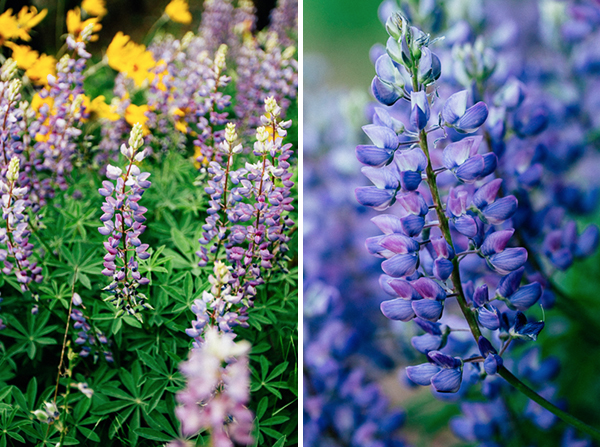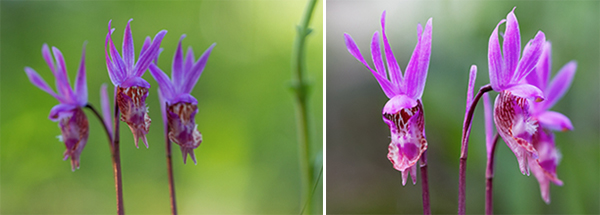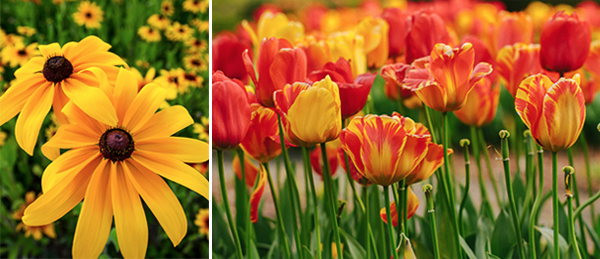 Spring is in the air… and this time of year brings the chance to photograph one of my favorite subjects—flowers!
Spring is in the air… and this time of year brings the chance to photograph one of my favorite subjects—flowers!
A big reason why I like photographing flowers so much is because they make the perfect subject for practicing composition. (They are extremely patient models!)
Spend a little time with the flowers at a botanical garden, neighborhood park, or even your own backyard and you’ll become a better photographer by honing your eye for composition.
You’ll also be able to apply what you learn to pretty much any photographic subject: the techniques that create a good flower photo are the same techniques that can help to improve any type of photograph.
Here are some tips for practice:
1. Get closer: More often than not, getting closer to the subject improves a photo—filling the frame with your main subject. You can do this by zooming in your lens, or by physically moving closer. This is also a great way to simplify a busy scene. Simple images typically have more impact and help the viewer to connect with the subject.

While the lupines in the shot on the left are lovely, the overall scene is a bit chaotic and the viewer’s eye may wander all over the photo. By comparison, in the photo on the right, the subject is obvious to the viewer and the overall scene is much simpler. This was achieved by choosing one flower to be the main subject, and then moving closer to fill the frame.
2. Watch your edges and background: It’s important to get in the habit of checking the edges of your frame to make sure no distractions are sneaking in. Similarly, keeping an eye on the background is important. You don’t want anything in the background or along the edges that will pull the viewer’s attention away from the subject.

In the photo on the left, there is a distracting stem that was easily excluded by getting closer to the flowers.

In the example on the left, notice how the background is very bright which pulls attention away from the subject. By taking a slightly different angle, I was able to easily exclude the distracting background, making for a stronger composition.
3. Work the shot: Don’t be satisfied with only one type of shot. Challenge yourself to keep refining, improving, and reworking the scene. Ask yourself questions such as, “What is the most important part of the scene? What should my subject be? Where do I want my viewer’s eye to go?”

One way to “work the shot” is to experiment with different angles. For example, in the shot on the left I got up above the flowers and angled the camera down. In the image on the right, I chose a low camera angle to be at the same level as the tulips. Changes in perspective can make a big difference in the overall image.

This example shows two very different photos made from the same subject. The possibilities are endless when you spend some time working with a scene.
4. Consider the Rule of Thirds: The idea here is that that putting the subject or points of interest off-center is one way to strengthen a composition. This isn’t to say you should never put the subject in the center… but oftentimes, moving it off-center creates a more dynamic image.

The photo on the left feels a bit static with the subject centered in the frame. Simply moving the flower to the upper left creates a more interesting composition.

To visualize the rule of thirds, it can help to imagine a tic-tac-toe board drawn across your frame. Moving the main subject or point of interest to one of the thirds lines or to an intersection point between two lines is usually a good way to improve a photo. In this example, I put the center of the flower near the upper third of the frame.
Becoming a better photographer is all about learning to pay attention to the smallest of details, which is why flowers make an ideal practice subject.
So give it a try… Challenge yourself to spend some time photographing flowers this spring, and you’ll see some great improvements in your photography skills.
[Editor’s Note: Learn more about how you can fund your travels and make an extra income with photography, travel writing, blogging, and more in our free online newsletter The Right Way to Travel. Sign up here today and we’ll send you a new report, Five Fun Ways To Get Paid To Travel: A Quick-Start Guide, completely FREE.]
